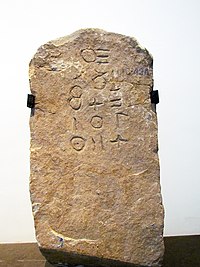
Back اللغة النوميدية Arabic Numid dili Azerbaijani Numidi Catalan Libysche Sprache German Idioma numidio Spanish Libyque French Numidysk Frisian Lingua númida Galician Numidijski jezik Croatian Bahasa Numidia ID
| Numidian | |
|---|---|
| Old Libyan | |
 Numidian stela with Libyc text in the Bardo National Museum | |
| Native to | ancient Numidia |
| Region | Mainly modern day Algeria, parts of Tunisia and parts of west Libya (as result of Numidian expansion but with Libyan Berber languages) |
| Ethnicity | Numidians |
| Extinct | Developed into, or replaced with various modern Berber languages in the 3rd century AD[1] |
Afro-Asiatic
| |
Early form | |
| Dialects |
|
| Libyco-Berber alphabet (Proto-Tifinagh) | |
| Language codes | |
| ISO 639-3 | nxm |
nxm | |
| Glottolog | numi1241 |
Numidian /n(j)uːˈmɪdiən/ was a language spoken in ancient Numidia. The script in which it was written, the Libyco-Berber alphabet (from which Tifinagh descended), has been almost fully deciphered and most characters (apart from a few exceptions restricted to specific areas) have known values. Despite this, the language has barely been transcribed and only a few words are known. Libyco-Berber inscriptions are attested from the 3rd century BC to the 3rd century AD. The language is scarcely attested and can be confidently identified only as belonging to the Afroasiatic family, although it was most likely part of the Berber languages, spoken at the start of the breakup of the Proto-Berber language.[2][3][4]
- ^ "Berbère". Archived from the original on 24 January 2015. Retrieved 1 May 2024.
c. 200 BC.
- ^ Daniels, Peter T.; Bright, William (1996). The World's Writing Systems. Oxford University Press. ISBN 978-0-19-507993-7.
- ^ Güldemann, Tom (10 September 2018). The Languages and Linguistics of Africa. Walter de Gruyter GmbH & Co KG. ISBN 978-3-11-042175-0.
- ^ Woodard, Roger D. (10 April 2008). The Ancient Languages of Syria-Palestine and Arabia. Cambridge University Press. ISBN 978-1-139-46934-0.